a 5.00 l sample of helium at stp expands to 15.0 l. what is the new pressure on the gas?
Chapter 9. Gases
9.2 Relating Pressure level, Volume, Amount, and Temperature: The Ideal Gas Law
Learning Objectives
By the end of this section, you volition be able to:
- Identify the mathematical relationships between the various properties of gases
- Use the ideal gas constabulary, and related gas laws, to compute the values of diverse gas backdrop under specified conditions
During the seventeenth and peculiarly eighteenth centuries, driven both by a desire to empathise nature and a quest to make balloons in which they could wing (Figure 1), a number of scientists established the relationships betwixt the macroscopic concrete properties of gases, that is, pressure, volume, temperature, and corporeality of gas. Although their measurements were not precise by today's standards, they were able to determine the mathematical relationships betwixt pairs of these variables (east.yard., pressure and temperature, pressure and volume) that hold for an platonic gas—a hypothetical construct that real gases approximate nether certain atmospheric condition. Eventually, these individual laws were combined into a unmarried equation—the ideal gas law—that relates gas quantities for gases and is quite accurate for low pressures and moderate temperatures. We will consider the key developments in individual relationships (for pedagogical reasons not quite in historical order), then put them together in the ideal gas law.

Pressure and Temperature: Amontons'south Law
Imagine filling a rigid container attached to a pressure level gauge with gas and and so sealing the container so that no gas may escape. If the container is cooled, the gas inside likewise gets colder and its force per unit area is observed to decrease. Since the container is rigid and tightly sealed, both the book and number of moles of gas remain constant. If nosotros heat the sphere, the gas within gets hotter (Figure 2) and the force per unit area increases.
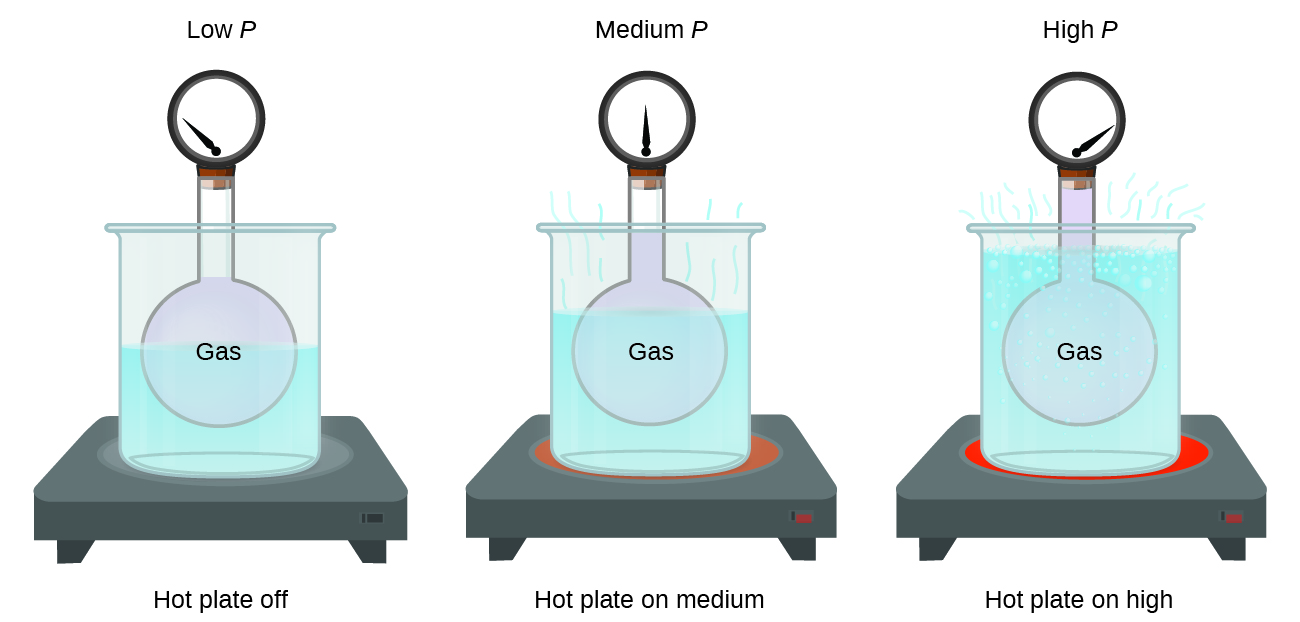
This human relationship between temperature and force per unit area is observed for any sample of gas confined to a abiding book. An instance of experimental pressure-temperature information is shown for a sample of air nether these atmospheric condition in Figure 3. We find that temperature and pressure are linearly related, and if the temperature is on the kelvin scale, and so P and T are directly proportional (again, when book and moles of gas are held constant); if the temperature on the kelvin scale increases by a certain factor, the gas force per unit area increases by the aforementioned factor.

Guillaume Amontons was the first to empirically establish the relationship between the pressure and the temperature of a gas (~1700), and Joseph Louis Gay-Lussac adamant the relationship more precisely (~1800). Because of this, the P–T relationship for gases is known every bit either Amontons's law or Gay-Lussac'due south law. Under either name, it states that the pressure of a given corporeality of gas is directly proportional to its temperature on the kelvin calibration when the volume is held constant. Mathematically, this can be written:
[latex]P\;\propto\;T \;\text{or} \; P = \text{constant} \times T \;\text{or} \; P = k \times T[/latex]
where ∝ means "is proportional to," and thou is a proportionality constant that depends on the identity, amount, and volume of the gas.
For a confined, constant book of gas, the ratio [latex]\frac{P}{T}[/latex] is therefore constant (i.e., [latex]\frac{P}{T} = k[/latex]). If the gas is initially in "Status 1" (with P = P 1 and T = T 1), and then changes to "Condition 2" (with P = P 2 and T = T 2), we have that [latex]\frac{P_1}{T_1} = k[/latex] and [latex]\frac{P_2}{T_2} = k[/latex], which reduces to [latex]\frac{P_1}{T_1} = \frac{P_2}{T_2}[/latex]. This equation is useful for pressure level-temperature calculations for a bars gas at abiding volume. Annotation that temperatures must be on the kelvin scale for whatsoever gas police force calculations (0 on the kelvin scale and the lowest possible temperature is called absolute zero). (Also notation that at that place are at to the lowest degree iii ways nosotros can depict how the pressure of a gas changes as its temperature changes: Nosotros can use a table of values, a graph, or a mathematical equation.)
Example 1
Predicting Alter in Pressure with Temperature
A tin of hair spray is used until information technology is empty except for the propellant, isobutane gas.
(a) On the can is the warning "Shop just at temperatures below 120 °F (48.8 °C). Practise not incinerate." Why?
(b) The gas in the can is initially at 24 °C and 360 kPa, and the can has a volume of 350 mL. If the can is left in a machine that reaches 50 °C on a hot day, what is the new pressure in the can?
Solution
(a) The can contains an corporeality of isobutane gas at a constant book, so if the temperature is increased by heating, the pressure will increase proportionately. High temperature could lead to high pressure level, causing the tin can to burst. (Also, isobutane is combustible, and then incineration could crusade the tin to explode.)
(b) We are looking for a pressure change due to a temperature change at constant volume, and then nosotros will apply Amontons's/Gay-Lussac's law. Taking P 1 and T 1 as the initial values, T 2 every bit the temperature where the pressure is unknown and P 2 as the unknown pressure, and converting °C to Thousand, we have:
[latex]\frac{P_1}{T_1} = \frac{P_2}{T_2} \;\text{which means that} \;\frac{360 \;\text{kPa}}{297 \;\text{G}} = \frac{P_2}{323 \;\text{K}}[/latex]
Rearranging and solving gives: [latex]P_2 = \frac{360 \;\text{kPa} \times 323 \;\rule[0.25ex]{0.5em}{0.1ex}\hspace{-0.5em}\text{G}}{297 \;\rule[0.25ex]{0.5em}{0.1ex}\hspace{-0.5em}\text{M}} = 390 \;\text{kPa}[/latex]
Check Your Learning
A sample of nitrogen, Ntwo, occupies 45.0 mL at 27 °C and 600 torr. What pressure level will it take if cooled to –73 °C while the book remains abiding?
Volume and Temperature: Charles's Law
If we fill a balloon with air and seal it, the balloon contains a specific amount of air at atmospheric force per unit area, let'southward say i atm. If we put the balloon in a refrigerator, the gas inside gets common cold and the balloon shrinks (although both the amount of gas and its force per unit area remain abiding). If we make the airship very cold, it volition shrink a great deal, and information technology expands once more when information technology warms upwardly.

This video shows how cooling and heating a gas causes its volume to decrease or increase, respectively.
These examples of the result of temperature on the volume of a given amount of a confined gas at constant pressure are true in general: The volume increases every bit the temperature increases, and decreases every bit the temperature decreases. Volume-temperature data for a i-mole sample of methane gas at i atm are listed and graphed in Effigy 4.
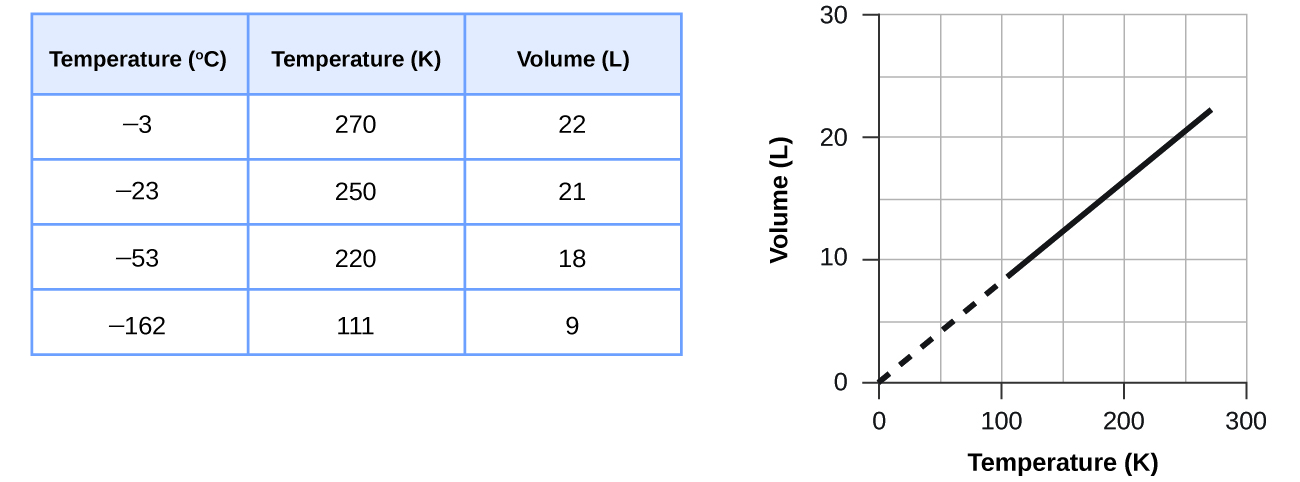
The relationship between the volume and temperature of a given amount of gas at abiding pressure level is known equally Charles's law in recognition of the French scientist and balloon flight pioneer Jacques Alexandre César Charles. Charles'south law states that the book of a given amount of gas is straight proportional to its temperature on the kelvin calibration when the pressure level is held constant.
Mathematically, this tin can be written as:
[latex]V \propto \; T \;\text{or} \; V = \text{constant} \cdot T \;\text{or} \; Five = g \cdot T \;\text{or} \; V_1 / T_1 = V_2 / T_2[/latex]
with grand being a proportionality constant that depends on the amount and force per unit area of the gas.
For a confined, abiding force per unit area gas sample, [latex]\frac{V}{T}[/latex] is constant (i.east., the ratio = g), and every bit seen with the P–T relationship, this leads to another form of Charles'due south law: [latex]\frac{V_1}{T_1} = \frac{V_2}{T_2}[/latex].
Example ii
Predicting Change in Volume with Temperature
A sample of carbon dioxide, CO2, occupies 0.300 L at 10 °C and 750 torr. What volume will the gas have at 30 °C and 750 torr?
Solution
Considering we are looking for the volume change caused by a temperature change at constant force per unit area, this is a chore for Charles'due south constabulary. Taking V 1 and T 1 as the initial values, T 2 as the temperature at which the volume is unknown and V 2 as the unknown volume, and converting °C into K we have:
[latex]\frac{V_1}{T_1} = \frac{V_2}{T_2} \;\text{which menas that} \frac{0.300 \;\text{50}}{283 \;\text{K}} = \frac{V_2}{303 \;\text{K}}[/latex]
Rearranging and solving gives: [latex]V_2 = \frac{0.300 \;\text{50} \times 303 \;\dominion[0.25ex]{0.8em}{0.1ex}\hspace{-0.8em}\text{Thousand} }{283 \;\dominion[0.25ex]{0.8em}{0.1ex}\hspace{-0.8em}\text{Chiliad}} = 0.321 \;\text{L}[/latex]
This answer supports our expectation from Charles's law, namely, that raising the gas temperature (from 283 K to 303 K) at a constant pressure will yield an increment in its volume (from 0.300 L to 0.321 L).
Check Your Learning
A sample of oxygen, Oii, occupies 32.2 mL at 30 °C and 452 torr. What book will information technology occupy at –70 °C and the same force per unit area?
Example 3
Measuring Temperature with a Volume Change
Temperature is sometimes measured with a gas thermometer by observing the change in the volume of the gas as the temperature changes at constant pressure. The hydrogen in a particular hydrogen gas thermometer has a volume of 150.0 cm3 when immersed in a mixture of ice and water (0.00 °C). When immersed in humid liquid ammonia, the volume of the hydrogen, at the same pressure, is 131.seven cm3. Discover the temperature of boiling ammonia on the kelvin and Celsius scales.
Solution
A volume alter caused by a temperature alter at constant pressure level means nosotros should employ Charles's law. Taking Five 1 and T one as the initial values, T 2 equally the temperature at which the book is unknown and V 2 every bit the unknown volume, and converting °C into K nosotros take:
[latex]\frac{V_1}{T_1} = \frac{V_2}{T_2} \;\text{which means that} \frac{150.0 \;\text{cm}^3}{273.15 \;\text{K}} = \frac{131.7 \;\text{cm}^3}{T_2}[/latex]
Rearrangement gives [latex]T_2 = \frac{131.7 \;\dominion[0.25ex]{0.8em}{0.1ex}\hspace{-0.8em}\text{cm}^3 \times 273.15 \;\text{Chiliad} }{150.0 \;\rule[0.25ex]{0.8em}{0.1ex}\hspace{-0.8em}\text{cm}^three} = 239.8 \;\text{K}[/latex]
Subtracting 273.15 from 239.8 Chiliad, nosotros discover that the temperature of the humid ammonia on the Celsius calibration is –33.4 °C.
Bank check Your Learning
What is the volume of a sample of ethane at 467 Thou and 1.1 atm if it occupies 405 mL at 298 K and ane.ane atm?
Book and Pressure: Boyle's Police force
If nosotros partially fill an airtight syringe with air, the syringe contains a specific amount of air at constant temperature, say 25 °C. If nosotros slowly push button in the plunger while keeping temperature constant, the gas in the syringe is compressed into a smaller volume and its force per unit area increases; if we pull out the plunger, the volume increases and the pressure decreases. This instance of the effect of volume on the force per unit area of a given amount of a confined gas is truthful in full general. Decreasing the volume of a contained gas will increase its pressure level, and increasing its volume will decrease its pressure. In fact, if the book increases by a sure factor, the pressure decreases by the same cistron, and vice versa. Volume-pressure information for an air sample at room temperature are graphed in Figure v.
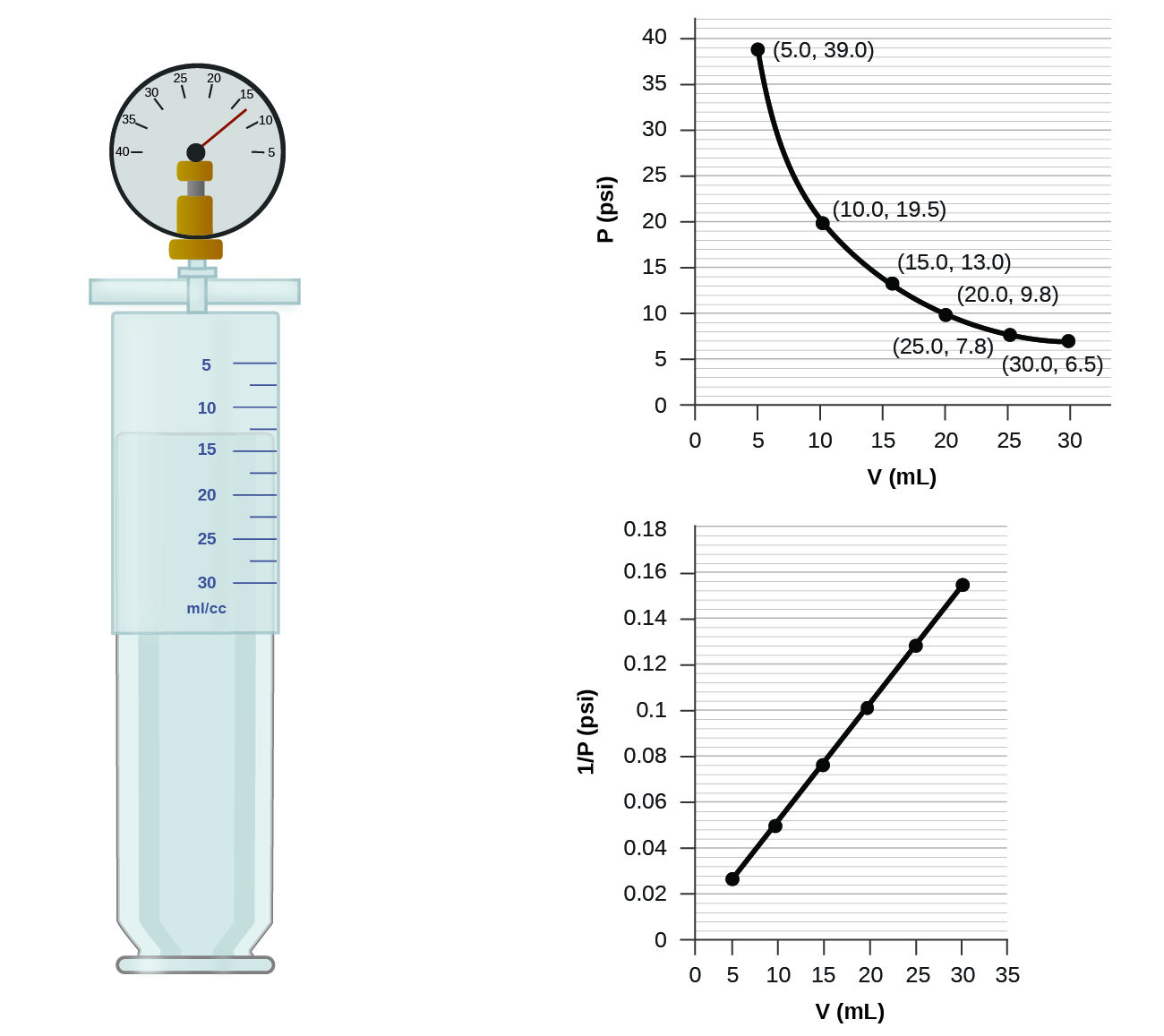
Unlike the P–T and 5–T relationships, pressure level and book are not straight proportional to each other. Instead, P and Five exhibit inverse proportionality: Increasing the pressure results in a decrease of the volume of the gas. Mathematically this can be written:
[latex]P \propto \; 1/V \;\text{or} \; P = yard \cdot 1/V \;\text{or} \; P \cdot V = one thousand \;\text{or} \; P_1 V_1 = P_2 V_2[/latex]
with k being a constant. Graphically, this relationship is shown past the directly line that results when plotting the inverse of the pressure ([latex]\frac{one}{P}[/latex]) versus the volume (V), or the inverse of volume ([latex]\frac{one}{5}[/latex]) versus the pressure (P). Graphs with curved lines are difficult to read accurately at low or high values of the variables, and they are more than difficult to use in plumbing fixtures theoretical equations and parameters to experimental data. For those reasons, scientists often endeavour to find a fashion to "linearize" their information. If we plot P versus V, nosotros obtain a hyperbola (run into Effigy 6).
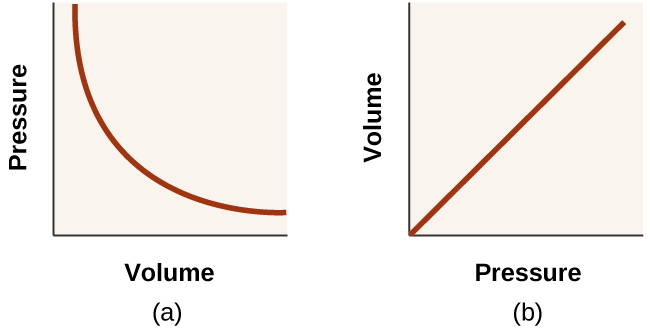
The human relationship between the volume and pressure of a given amount of gas at abiding temperature was outset published by the English natural philosopher Robert Boyle over 300 years ago. It is summarized in the statement at present known as Boyle's police: The volume of a given corporeality of gas held at abiding temperature is inversely proportional to the pressure nether which information technology is measured.
Instance 4
Volume of a Gas Sample
The sample of gas in Figure 5 has a volume of xv.0 mL at a force per unit area of 13.0 psi. Make up one's mind the pressure level of the gas at a book of 7.5 mL, using:
(a) the P–Five graph in Figure v
(b) the [latex]\frac{1}{p}[/latex] vs. 5 graph in Figure five
(c) the Boyle's law equation
Annotate on the likely accuracy of each method.
Solution
(a) Estimating from the P–V graph gives a value for P somewhere around 27 psi.
(b) Estimating from the [latex]\frac{1}{P}[/latex] versus Five graph requite a value of about 26 psi.
(c) From Boyle's police force, nosotros know that the product of pressure and volume (PV) for a given sample of gas at a constant temperature is ever equal to the same value. Therefore we have P 1 V 1 = yard and P 2 5 2 = thou which means that P ane Five one = P 2 Five 2.
Using P one and V one as the known values 13.0 psi and 15.0 mL, P 2 as the pressure at which the volume is unknown, and Five 2 as the unknown volume, nosotros have:
[latex]P_1 V_1 = P_2 V_2 \;\text{or} \; 13.0 \;\text{psi} \times 15.0 \;\text{mL} = P_2 \times vii.5 \;\text{mL}[/latex]
Solving:
[latex]P_2 = \frac{13.0 \;\text{psi} \times 15.0 \;\rule[0.5ex]{one.2em}{0.1ex}\hspace{-ane.2em}\text{mL}}{7.five \;\rule[0.5ex]{1.2em}{0.1ex}\hspace{-1.2em}\text{mL}} = 26 \;\text{psi}[/latex]
It was more difficult to judge well from the P–V graph, then (a) is likely more inaccurate than (b) or (c). The calculation will exist every bit accurate equally the equation and measurements allow.
Bank check Your Learning
The sample of gas in Figure 5 has a book of 30.0 mL at a force per unit area of 6.5 psi. Determine the book of the gas at a pressure of 11.0 psi, using:
(a) the P–5 graph in Effigy 5
(b) the [latex]\frac{1}{P}[/latex] vs. Five graph in Figure v
(c) the Boyle's law equation
Comment on the likely accuracy of each method.
Respond:
(a) about 17–eighteen mL; (b) ~18 mL; (c) 17.7 mL; it was more hard to estimate well from the P–V graph, so (a) is likely more than inaccurate than (b); the calculation will be as accurate as the equation and measurements allow
Breathing and Boyle's Constabulary
What do you lot practice most 20 times per infinitesimal for your whole life, without break, and ofttimes without even being aware of it? The reply, of form, is respiration, or breathing. How does it work? It turns out that the gas laws apply here. Your lungs take in gas that your torso needs (oxygen) and get rid of waste gas (carbon dioxide). Lungs are made of spongy, stretchy tissue that expands and contracts while yous breathe. When you inhale, your diaphragm and intercostal muscles (the muscles between your ribs) contract, expanding your chest cavity and making your lung volume larger. The increase in volume leads to a decrease in force per unit area (Boyle'south police). This causes air to flow into the lungs (from loftier pressure to depression force per unit area). When you exhale, the procedure reverses: Your diaphragm and rib muscles relax, your breast cavity contracts, and your lung volume decreases, causing the pressure to increase (Boyle's law again), and air flows out of the lungs (from loftier pressure level to depression pressure). You and then breathe in and out again, and once more, repeating this Boyle'southward law cycle for the remainder of your life (Effigy 7).
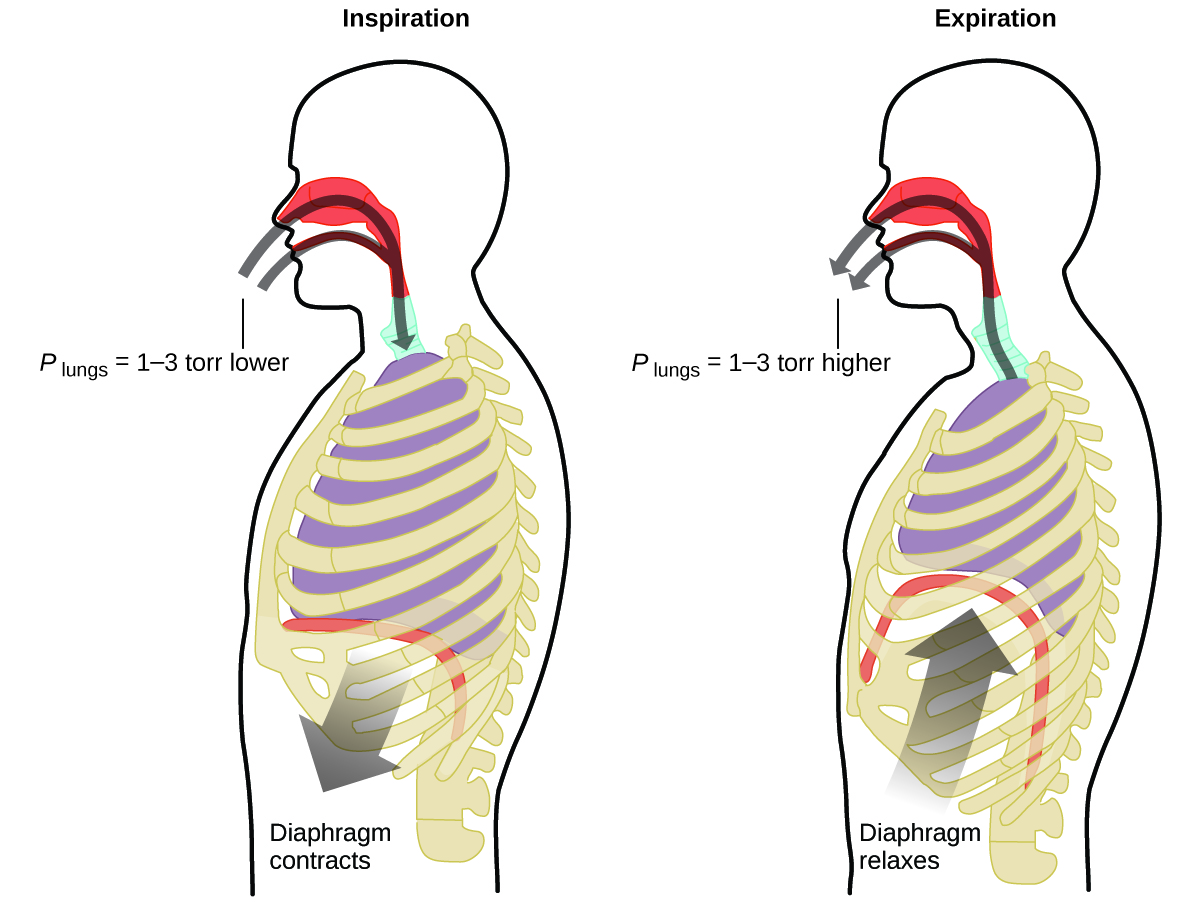
Moles of Gas and Book: Avogadro's Law
The Italian scientist Amedeo Avogadro advanced a hypothesis in 1811 to account for the behavior of gases, stating that equal volumes of all gases, measured under the aforementioned conditions of temperature and force per unit area, contain the same number of molecules. Over fourth dimension, this human relationship was supported by many experimental observations as expressed by Avogadro'south constabulary: For a confined gas, the volume (V) and number of moles (n) are direct proportional if the pressure and temperature both remain constant.
In equation grade, this is written as:
[latex]Five \propto n \;\text{or} \; V = k \times n \;\text{or} \; \frac{V_1}{n_1} = \frac{V_2}{n_2}[/latex]
Mathematical relationships tin as well be determined for the other variable pairs, such as P versus n, and n versus T.

Visit this interactive PhET simulation to investigate the relationships between force per unit area, volume, temperature, and corporeality of gas. Utilise the simulation to examine the effect of changing i parameter on another while holding the other parameters constant (as described in the preceding sections on the diverse gas laws).
The Ideal Gas Police
To this point, four separate laws have been discussed that chronicle pressure, book, temperature, and the number of moles of the gas:
- Boyle'southward law: PV = abiding at constant T and north
- Amontons's constabulary: [latex]\frac{P}{T}[/latex] = abiding at constant Five and n
- Charles's law: [latex]\frac{V}{T}[/latex] = constant at abiding P and n
- Avogadro'due south law: [latex]\frac{5}{n}[/latex] = abiding at constant P and T
Combining these iv laws yields the ideal gas law, a relation between the pressure, volume, temperature, and number of moles of a gas:
[latex]PV = nRT[/latex]
where P is the pressure of a gas, V is its volume, northward is the number of moles of the gas, T is its temperature on the kelvin scale, and R is a abiding called the ideal gas abiding or the universal gas constant. The units used to express pressure level, volume, and temperature will make up one's mind the proper grade of the gas constant as required past dimensional analysis, the most usually encountered values being 0.08206 Fifty atm mol–1 K–i and viii.314 kPa Fifty mol–ane One thousand–1.
Gases whose properties of P, V, and T are accurately described by the ideal gas law (or the other gas laws) are said to exhibit ideal behavior or to approximate the traits of an ideal gas. An ideal gas is a hypothetical construct that may be used along with kinetic molecular theory to effectively explicate the gas laws as volition be described in a later module of this chapter. Although all the calculations presented in this module assume ideal behavior, this supposition is simply reasonable for gases under conditions of relatively depression pressure and loftier temperature. In the final module of this chapter, a modified gas law volition exist introduced that accounts for the not-platonic beliefs observed for many gases at relatively high pressures and low temperatures.
The ideal gas equation contains five terms, the gas constant R and the variable backdrop P, V, n, and T. Specifying any 4 of these terms volition permit employ of the platonic gas law to calculate the fifth term every bit demonstrated in the following example exercises.
Example 5
Using the Ideal Gas Law
Methane, CH4, is being considered for use every bit an culling automotive fuel to replace gasoline. One gallon of gasoline could be replaced by 655 g of CH4. What is the volume of this much methane at 25 °C and 745 torr?
Solution
We must rearrange PV = nRT to solve for V: [latex]Five = \frac{nRT}{P}[/latex]
If we choose to utilise R = 0.08206 L atm mol–1 K–1, and then the amount must exist in moles, temperature must be in kelvin, and pressure level must be in atm.
Converting into the "right" units:
[latex]northward = 655 \;\rule[0.5ex]{2.5em}{0.1ex}\hspace{-2.5em}\text{g CH}_4 \times \frac{one \;\text{mol}}{16.043 \;\rule[0.5ex]{2.2em}{0.1ex}\hspace{-2.2em}\text{chiliad CH}_4} = xl.8 \;\text{mol}[/latex]
[latex]T = 25 \;^\circ\text{C} + 273 = 298 \;\text{K}[/latex]
[latex]P = 745 \;\dominion[0.5ex]{1.8em}{0.1ex}\hspace{-ane.8em}\text{torr} \times \frac{1 \;\text{atm}}{760 \;\rule[0.5ex]{1.4em}{0.1ex}\hspace{-one.4em}\text{torr}} = 0.980 \;\text{atm}[/latex]
[latex]V = \frac{nRT}{P} = \frac{(40.8 \;\rule[0.5ex]{1.2em}{0.1ex}\hspace{-1.2em}\text{mol})(0.08206 \text{L}\;\rule[0.5ex]{5.1em}{0.1ex}\hspace{-5.1em}\text{atm mol}^{-1} \;\text{K}^{-ane})(298 \;\rule[0.5ex]{0.6em}{0.1ex}\hspace{-0.6em}\text{K})}{0.980 \;\rule[0.5ex]{one.5em}{0.1ex}\hspace{-1.5em}\text{atm}} = one.02 \times ten^iii \;\text{L}[/latex]
It would require 1020 Fifty (269 gal) of gaseous methane at about i atm of pressure to replace 1 gal of gasoline. It requires a big container to concur enough methane at 1 atm to replace several gallons of gasoline.
Check Your Learning
Summate the pressure in bar of 2520 moles of hydrogen gas stored at 27 °C in the 180-L storage tank of a modern hydrogen-powered auto.
If the number of moles of an ideal gas are kept constant nether two different sets of weather condition, a useful mathematical relationship called the combined gas police is obtained: [latex]\frac{P_1 V_1}{T_1} = \frac{P_2 V_2}{T_2}[/latex] using units of atm, L, and K. Both sets of conditions are equal to the product of n ×R (where n = the number of moles of the gas and R is the ideal gas police constant).
Example 6
Using the Combined Gas Constabulary
When filled with air, a typical scuba tank with a volume of thirteen.2 L has a pressure of 153 atm (Figure 8). If the h2o temperature is 27 °C, how many liters of air will such a tank provide to a diver's lungs at a depth of approximately 70 feet in the bounding main where the pressure is 3.thirteen atm?
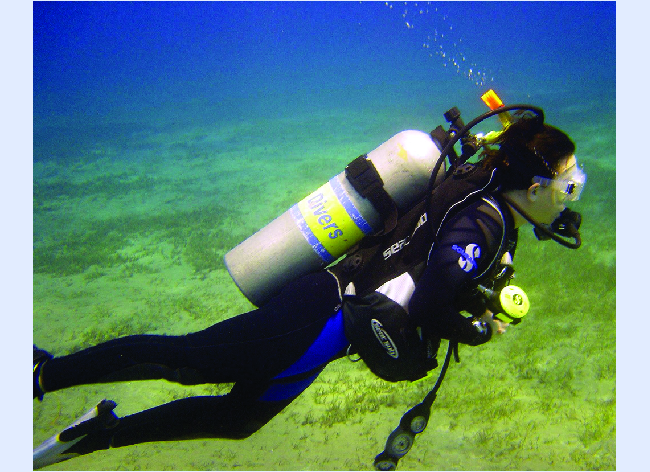
Letting 1 represent the air in the scuba tank and 2 represent the air in the lungs, and noting that body temperature (the temperature the air will be in the lungs) is 37 °C, we have:
[latex]\frac{P_1 V_1}{T_1} = \frac{P_2 V_2}{T_2} \longrightarrow \frac{(153 \;\text{atm})(13.2 \;\text{50})}{(300 \;\text{K})} = \frac{(3.thirteen \;\text{atm})(V_2)}{(310 \;\text{K})}[/latex]
Solving for V 2:
[latex]V_2 = \frac{(153 \;\rule[0.5ex]{1.2em}{0.1ex}\hspace{-1.2em}\text{atm})(13.two \;\text{L})(310 \;\rule[0.5ex]{0.5em}{0.1ex}\hspace{-0.5em}\text{K})}{(300 \;\rule[0.5ex]{0.5em}{0.1ex}\hspace{-0.5em}\text{1000})(3.xiii \;\rule[0.5ex]{1.2em}{0.1ex}\hspace{-1.2em}\text{atm})} = 667 \;\text{L}[/latex]
(Note: Be brash that this item example is ane in which the assumption of ideal gas behavior is not very reasonable, since information technology involves gases at relatively high pressures and low temperatures. Despite this limitation, the calculated book tin can be viewed as a good "ballpark" estimate.)
Check Your Learning
A sample of ammonia is establish to occupy 0.250 50 under laboratory conditions of 27 °C and 0.850 atm. Find the book of this sample at 0 °C and ane.00 atm.
The Interdependence between Ocean Depth and Pressure in Scuba Diving
Whether scuba diving at the Groovy Barrier Reef in Australia (shown in Figure 9) or in the Caribbean, divers must understand how pressure affects a number of issues related to their comfort and safety.
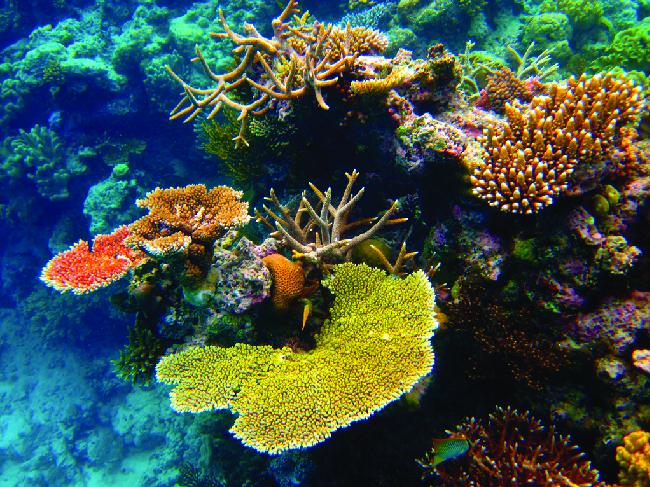
Pressure increases with sea depth, and the pressure changes most speedily every bit divers achieve the surface. The pressure a diver experiences is the sum of all pressures in a higher place the diver (from the water and the air). Most pressure measurements are given in units of atmospheres, expressed equally "atmospheres absolute" or ATA in the diving customs: Every 33 anxiety of common salt water represents ane ATA of force per unit area in improver to one ATA of pressure from the temper at sea level. As a diver descends, the increase in pressure causes the body's air pockets in the ears and lungs to shrink; on the rising, the subtract in pressure causes these air pockets to expand, potentially rupturing eardrums or bursting the lungs. Divers must therefore undergo equalization by adding air to trunk airspaces on the descent by breathing normally and adding air to the mask past animate out of the nose or adding air to the ears and sinuses by equalization techniques; the corollary is as well true on ascent, divers must release air from the body to maintain equalization. Buoyancy, or the ability to control whether a diver sinks or floats, is controlled past the buoyancy compensator (BCD). If a diver is ascending, the air in his BCD expands because of lower pressure according to Boyle'southward law (decreasing the pressure of gases increases the volume). The expanding air increases the buoyancy of the diver, and she or he begins to ascend. The diver must vent air from the BCD or take chances an uncontrolled ascension that could rupture the lungs. In descending, the increased pressure causes the air in the BCD to compress and the diver sinks much more quickly; the diver must add air to the BCD or risk an uncontrolled descent, facing much higher pressures near the ocean floor. The pressure too impacts how long a diver tin can stay underwater before ascending. The deeper a diver dives, the more compressed the air that is breathed because of increased pressure: If a diver dives 33 feet, the pressure is two ATA and the air would be compressed to i-half of its original volume. The diver uses up available air twice every bit fast every bit at the surface.
Standard Conditions of Temperature and Pressure
We have seen that the volume of a given quantity of gas and the number of molecules (moles) in a given book of gas vary with changes in pressure and temperature. Chemists sometimes make comparisons confronting a standard temperature and pressure (STP) for reporting backdrop of gases: 273.15 Thousand and one atm (101.325 kPa). At STP, an ideal gas has a book of nearly 22.four L—this is referred to as the standard tooth volume (Figure 10).
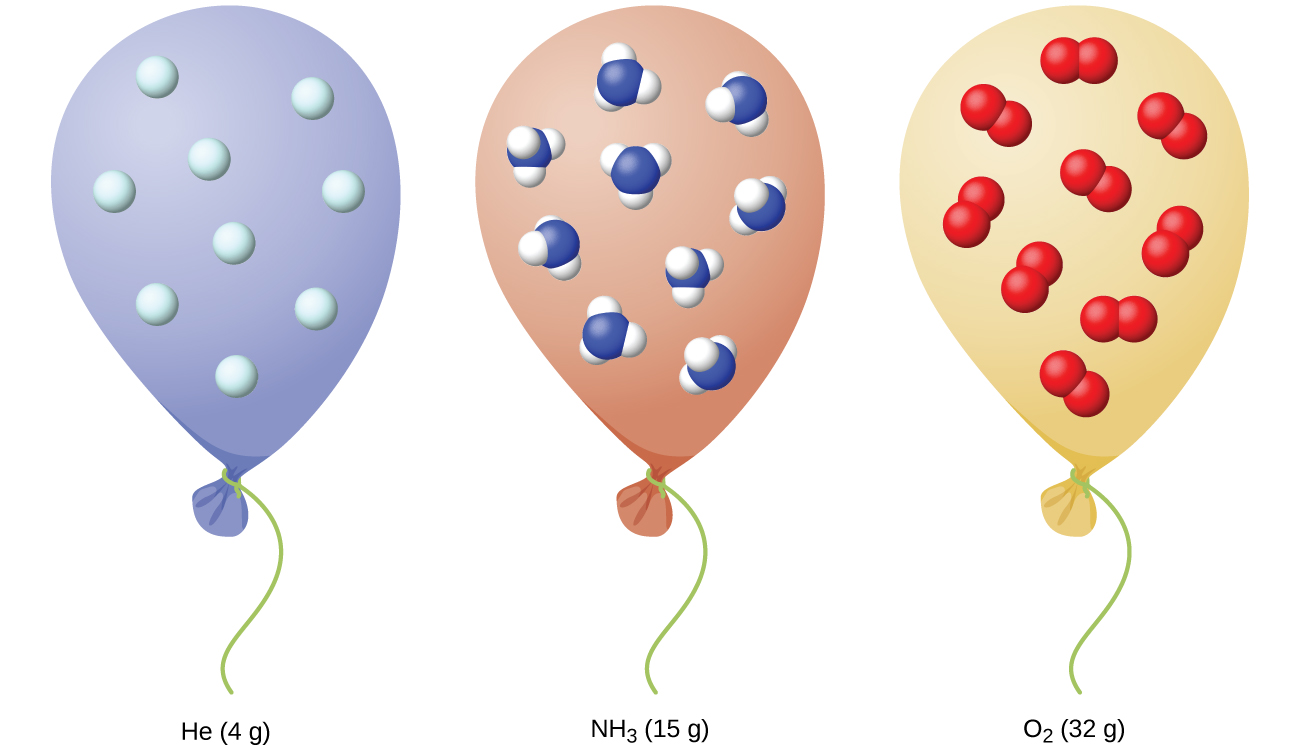
Cardinal Concepts and Summary
The behavior of gases can be described by several laws based on experimental observations of their properties. The pressure of a given corporeality of gas is directly proportional to its absolute temperature, provided that the volume does non change (Amontons's police force). The volume of a given gas sample is directly proportional to its absolute temperature at constant pressure (Charles'due south law). The volume of a given amount of gas is inversely proportional to its pressure when temperature is held constant (Boyle'south constabulary). Nether the aforementioned conditions of temperature and pressure, equal volumes of all gases contain the same number of molecules (Avogadro's law).
The equations describing these laws are special cases of the ideal gas law, PV = nRT, where P is the pressure of the gas, V is its volume, north is the number of moles of the gas, T is its kelvin temperature, and R is the platonic (universal) gas constant.
Primal Equations
- PV = nRT
Chemical science End of Chapter Exercises
- Sometimes leaving a bicycle in the lord's day on a hot day volition cause a blowout. Why?
- Explain how the book of the bubbling exhausted by a scuba diver (Figure 8) change every bit they rise to the surface, assuming that they remain intact.
- One way to land Boyle's law is "All other things beingness equal, the pressure of a gas is inversely proportional to its volume." (a) What is the significant of the term "inversely proportional?" (b) What are the "other things" that must be equal?
- An alternate fashion to land Avogadro'south law is "All other things being equal, the number of molecules in a gas is directly proportional to the volume of the gas." (a) What is the meaning of the term "direct proportional?" (b) What are the "other things" that must be equal?
- How would the graph in Figure 4 change if the number of moles of gas in the sample used to determine the curve were doubled?
- How would the graph in Figure 5 change if the number of moles of gas in the sample used to decide the bend were doubled?
- In addition to the data establish in Effigy 5, what other information exercise we need to find the mass of the sample of air used to determine the graph?
- Determine the volume of ane mol of CHiv gas at 150 Yard and 1 atm, using Effigy 4.
- Decide the pressure of the gas in the syringe shown in Effigy 5 when its book is 12.five mL, using:
(a) the appropriate graph
(b) Boyle's police
- A spray can is used until it is empty except for the propellant gas, which has a pressure of 1344 torr at 23 °C. If the can is thrown into a burn down (T = 475 °C), what will be the pressure in the hot can?
- What is the temperature of an eleven.2-L sample of carbon monoxide, CO, at 744 torr if it occupies thirteen.3 L at 55 °C and 744 torr?
- A 2.l-Fifty volume of hydrogen measured at –196 °C is warmed to 100 °C. Calculate the volume of the gas at the higher temperature, assuming no change in pressure.
- A balloon inflated with iii breaths of air has a volume of 1.7 L. At the aforementioned temperature and pressure, what is the volume of the balloon if five more same-sized breaths are added to the balloon?
- A weather airship contains viii.eighty moles of helium at a pressure of 0.992 atm and a temperature of 25 °C at ground level. What is the volume of the airship nether these conditions?
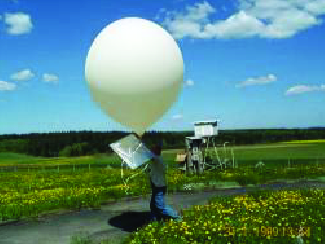
- The volume of an automobile air handbag was 66.8 50 when inflated at 25 °C with 77.eight k of nitrogen gas. What was the pressure in the bag in kPa?
- How many moles of gaseous boron trifluoride, BF3, are contained in a iv.3410-Fifty bulb at 788.0 K if the pressure level is 1.220 atm? How many grams of BF3?
- Iodine, Itwo, is a solid at room temperature but sublimes (converts from a solid into a gas) when warmed. What is the temperature in a 73.3-mL seedling that contains 0.292 grand of I2 vapor at a pressure of 0.462 atm?
- How many grams of gas are present in each of the following cases?
(a) 0.100 50 of CO2 at 307 torr and 26 °C
(b) 8.75 L of CtwoH4, at 378.3 kPa and 483 K
(c) 221 mL of Ar at 0.23 torr and –54 °C
- A loftier altitude airship is filled with ane.41 × 104 50 of hydrogen at a temperature of 21 °C and a pressure of 745 torr. What is the volume of the airship at a height of xx km, where the temperature is –48 °C and the force per unit area is 63.1 torr?
- A cylinder of medical oxygen has a volume of 35.4 L, and contains O2 at a force per unit area of 151 atm and a temperature of 25 °C. What volume of O2 does this correspond to at normal trunk weather, that is, one atm and 37 °C?
- A large scuba tank (Figure 8) with a volume of 18 50 is rated for a pressure of 220 bar. The tank is filled at 20 °C and contains enough air to supply 1860 L of air to a diver at a pressure of 2.37 atm (a depth of 45 feet). Was the tank filled to capacity at twenty °C?
- A 20.0-L cylinder containing 11.34 kg of butane, CivH10, was opened to the atmosphere. Calculate the mass of the gas remaining in the cylinder if it were opened and the gas escaped until the force per unit area in the cylinder was equal to the atmospheric pressure, 0.983 atm, and a temperature of 27 °C.
- While resting, the average 70-kg human male consumes 14 L of pure O2 per 60 minutes at 25 °C and 100 kPa. How many moles of O2 are consumed by a 70 kg human while resting for ane.0 h?
- For a given amount of gas showing ideal behavior, depict labeled graphs of:
(a) the variation of P with Five
(b) the variation of V with T
(c) the variation of P with T
(d) the variation of [latex]\frac{ane}{P}[/latex] with 5
- A liter of methane gas, CH4, at STP contains more atoms of hydrogen than does a liter of pure hydrogen gas, H2, at STP. Using Avogadro'due south law every bit a starting indicate, explicate why.
- The effect of chlorofluorocarbons (such as CCl2Fii) on the depletion of the ozone layer is well known. The use of substitutes, such as CHthreeCH2F(m), for the chlorofluorocarbons, has largely corrected the problem. Calculate the volume occupied by 10.0 g of each of these compounds at STP:
(a) CCl2F2(one thousand)
(b) CHiiiCH2F(grand)
- As 1 one thousand of the radioactive element radium decays over 1 year, information technology produces 1.xvi × 1018 alpha particles (helium nuclei). Each blastoff particle becomes an atom of helium gas. What is the pressure in pascal of the helium gas produced if it occupies a volume of 125 mL at a temperature of 25 °C?
- A balloon that is 100.21 L at 21 °C and 0.981 atm is released and just barely clears the pinnacle of Mount Crumpet in British Columbia. If the final volume of the balloon is 144.53 L at a temperature of 5.24 °C, what is the pressure experienced past the airship equally it clears Mount Crumpet?
- If the temperature of a fixed amount of a gas is doubled at constant volume, what happens to the pressure?
- If the book of a stock-still amount of a gas is tripled at constant temperature, what happens to the pressure?
Glossary
- absolute nil
- temperature at which the volume of a gas would be zero according to Charles'southward police.
- Amontons'southward law
- (also, Gay-Lussac's police) pressure of a given number of moles of gas is directly proportional to its kelvin temperature when the volume is held constant
- Avogadro'southward police
- volume of a gas at abiding temperature and pressure is proportional to the number of gas molecules
- Boyle'due south law
- volume of a given number of moles of gas held at constant temperature is inversely proportional to the pressure under which it is measured
- Charles'due south constabulary
- volume of a given number of moles of gas is directly proportional to its kelvin temperature when the pressure is held constant
- platonic gas
- hypothetical gas whose physical properties are perfectly described by the gas laws
- platonic gas abiding (R)
- constant derived from the platonic gas equation R = 0.08226 Fifty atm mol–1 1000–one or viii.314 L kPa mol–1 K–ane
- ideal gas police
- relation between the pressure, volume, amount, and temperature of a gas under conditions derived by combination of the elementary gas laws
- standard conditions of temperature and pressure level (STP)
- 273.15 Thou (0 °C) and 1 atm (101.325 kPa)
- standard molar volume
- book of ane mole of gas at STP, approximately 22.4 L for gases behaving ideally
Solutions
Answers to Chemistry End of Chapter Exercises
2. As the bubbles ascension, the pressure level decreases, and then their volume increases as suggested by Boyle'south law.
4. (a) The number of particles in the gas increases as the volume increases. (b) temperature, pressure
six. The curve would be further to the right and to a higher place, but the same basic shape.
eight. 16.3 to 16.5 Fifty
x. three.40 × 103 torr
12. 12.1 L
fourteen. 217 L
xvi. 8.190 × x–2 mol; 5.553 g
18. (a) 7.24 × 10–2 1000; (b) 23.1 m; (c) 1.5 × x–4 m
20. 5561 Fifty
22. 46.four g
24. For a gas exhibiting ideal behavior:
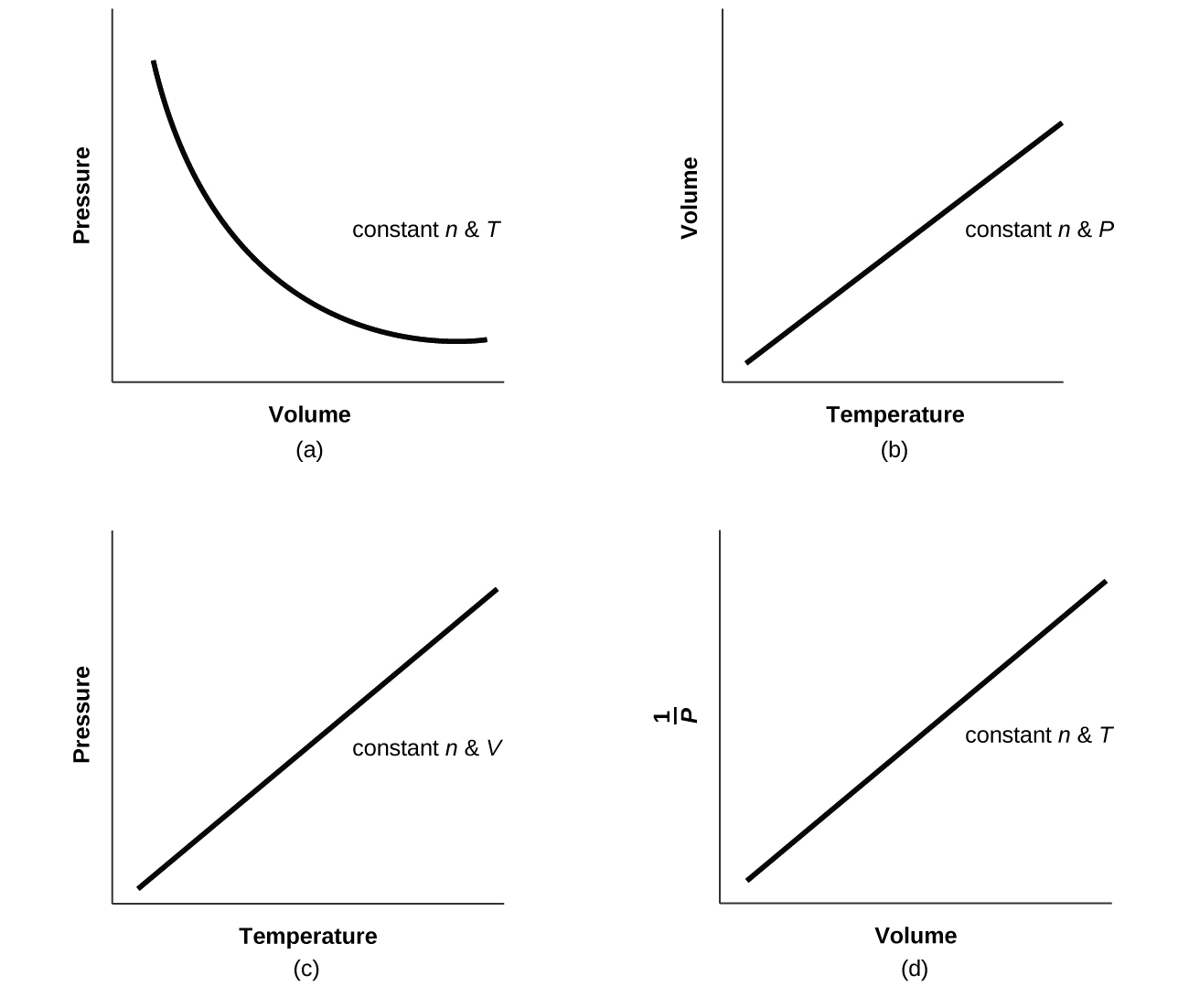
26. (a) ane.85 L CCltwoF2; (b) 4.66 L CH3CH2F
28. 0.644 atm
30. The pressure level decreases by a factor of iii.
Source: https://opentextbc.ca/chemistry/chapter/9-2-relating-pressure-volume-amount-and-temperature-the-ideal-gas-law/
0 Response to "a 5.00 l sample of helium at stp expands to 15.0 l. what is the new pressure on the gas?"
Publicar un comentario